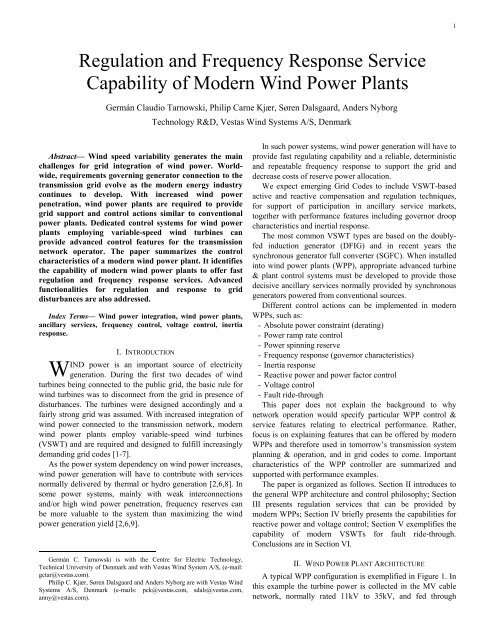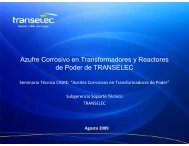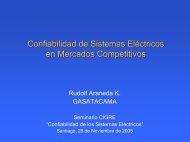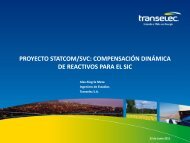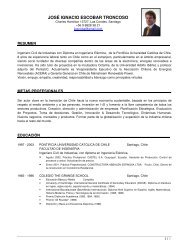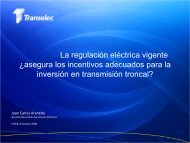Regulation and Frequency Response Service Capability of Modern ...
Regulation and Frequency Response Service Capability of Modern ...
Regulation and Frequency Response Service Capability of Modern ...
You also want an ePaper? Increase the reach of your titles
YUMPU automatically turns print PDFs into web optimized ePapers that Google loves.
1<br />
<strong>Regulation</strong> <strong>and</strong> <strong>Frequency</strong> <strong>Response</strong> <strong>Service</strong><br />
<strong>Capability</strong> <strong>of</strong> <strong>Modern</strong> Wind Power Plants<br />
Germán Claudio Tarnowski, Philip Carne Kjær, Søren Dalsgaard, Anders Nyborg<br />
Technology R&D, Vestas Wind Systems A/S, Denmark<br />
Abstract— Wind speed variability generates the main<br />
challenges for grid integration <strong>of</strong> wind power. Worldwide,<br />
requirements governing generator connection to the<br />
transmission grid evolve as the modern energy industry<br />
continues to develop. With increased wind power<br />
penetration, wind power plants are required to provide<br />
grid support <strong>and</strong> control actions similar to conventional<br />
power plants. Dedicated control systems for wind power<br />
plants employing variable-speed wind turbines can<br />
provide advanced control features for the transmission<br />
network operator. The paper summarizes the control<br />
characteristics <strong>of</strong> a modern wind power plant. It identifies<br />
the capability <strong>of</strong> modern wind power plants to <strong>of</strong>fer fast<br />
regulation <strong>and</strong> frequency response services. Advanced<br />
functionalities for regulation <strong>and</strong> response to grid<br />
disturbances are also addressed.<br />
Index Terms— Wind power integration, wind power plants,<br />
ancillary services, frequency control, voltage control, inertia<br />
response.<br />
W<br />
I. INTRODUCTION<br />
IND power is an important source <strong>of</strong> electricity<br />
generation. During the first two decades <strong>of</strong> wind<br />
turbines being connected to the public grid, the basic rule for<br />
wind turbines was to disconnect from the grid in presence <strong>of</strong><br />
disturbances. The turbines were designed accordingly <strong>and</strong> a<br />
fairly strong grid was assumed. With increased integration <strong>of</strong><br />
wind power connected to the transmission network, modern<br />
wind power plants employ variable-speed wind turbines<br />
(VSWT) <strong>and</strong> are required <strong>and</strong> designed to fulfill increasingly<br />
dem<strong>and</strong>ing grid codes [1-7].<br />
As the power system dependency on wind power increases,<br />
wind power generation will have to contribute with services<br />
normally delivered by thermal or hydro generation [2,6,8]. In<br />
some power systems, mainly with weak interconnections<br />
<strong>and</strong>/or high wind power penetration, frequency reserves can<br />
be more valuable to the system than maximizing the wind<br />
power generation yield [2,6,9].<br />
Germán C. Tarnowski is with the Centre for Electric Technology,<br />
Technical University <strong>of</strong> Denmark <strong>and</strong> with Vestas Wind System A/S, (e-mail:<br />
gctar@vestas.com).<br />
Philip C. Kjær, Søren Dalsgaard <strong>and</strong> Anders Nyborg are with Vestas Wind<br />
Systems A/S, Denmark (e-mails: pck@vestas.com, sdals@vestas.com,<br />
anny@vestas.com).<br />
In such power systems, wind power generation will have to<br />
provide fast regulating capability <strong>and</strong> a reliable, deterministic<br />
<strong>and</strong> repeatable frequency response to support the grid <strong>and</strong><br />
decrease costs <strong>of</strong> reserve power allocation.<br />
We expect emerging Grid Codes to include VSWT-based<br />
active <strong>and</strong> reactive compensation <strong>and</strong> regulation techniques,<br />
for support <strong>of</strong> participation in ancillary service markets,<br />
together with performance features including governor droop<br />
characteristics <strong>and</strong> inertial response.<br />
The most common VSWT types are based on the doublyfed<br />
induction generator (DFIG) <strong>and</strong> in recent years the<br />
synchronous generator full converter (SGFC). When installed<br />
into wind power plants (WPP), appropriate advanced turbine<br />
& plant control systems must be developed to provide those<br />
decisive ancillary services normally provided by synchronous<br />
generators powered from conventional sources.<br />
Different control actions can be implemented in modern<br />
WPPs, such as:<br />
- Absolute power constraint (derating)<br />
- Power ramp rate control<br />
- Power spinning reserve<br />
- <strong>Frequency</strong> response (governor characteristics)<br />
- Inertia response<br />
- Reactive power <strong>and</strong> power factor control<br />
- Voltage control<br />
- Fault ride-through<br />
This paper does not explain the background to why<br />
network operation would specify particular WPP control &<br />
service features relating to electrical performance. Rather,<br />
focus is on explaining features that can be <strong>of</strong>fered by modern<br />
WPPs <strong>and</strong> therefore used in tomorrow’s transmission system<br />
planning & operation, <strong>and</strong> in grid codes to come. Important<br />
characteristics <strong>of</strong> the WPP controller are summarized <strong>and</strong><br />
supported with performance examples.<br />
The paper is organized as follows. Section II introduces to<br />
the general WPP architecture <strong>and</strong> control philosophy; Section<br />
III presents regulation services that can be provided by<br />
modern WPPs; Section IV briefly presents the capabilities for<br />
reactive power <strong>and</strong> voltage control; Section V exemplifies the<br />
capability <strong>of</strong> modern VSWTs for fault ride-through.<br />
Conclusions are in Section VI.<br />
II. WIND POWER PLANT ARCHITECTURE<br />
A typical WPP configuration is exemplified in Figure 1. In<br />
this example the turbine power is collected in the MV cable<br />
network, normally rated 11kV to 35kV, <strong>and</strong> fed through
2<br />
radials to the plant substation. The substation hosts HV <strong>and</strong><br />
MV switchgear, plant transformer, measurements, protection,<br />
master controller <strong>and</strong> communication. In addition, the<br />
substation MV bus can connect to reactive power<br />
compensation equipment, such as mechanically switched<br />
capacitors or reactors (MSC, MSR) or static VAr<br />
compensators (SVC, STATCOM). Figure 1 shows the circuit<br />
to the point <strong>of</strong> common coupling (PCC) <strong>and</strong> exemplifies some<br />
relevant possible communication/control links.<br />
The Point <strong>of</strong> Measurement (PoM) for three-phase voltages<br />
<strong>and</strong> currents may coincide in most <strong>of</strong> the cases with the PCC –<br />
but the PCC could also be upstream from the PoM. A<br />
centralized power plant controller (PPC) receives inputs from<br />
PoM <strong>and</strong> executes the WPP control loops, e.g. voltage,<br />
frequency, reactive <strong>and</strong> active power controls using the<br />
reference targets sent by, for instance, the Grid Operator <strong>and</strong><br />
further dispatch the active <strong>and</strong> reactive power references to<br />
VSWTs <strong>and</strong> any reactive power compensation equipment, so<br />
the PPC is acting as master controller <strong>of</strong> the WPP.<br />
SCADA can be separate from power plant controller to<br />
realize reliable & deterministic plant performance. SCADA<br />
may still monitor all plant equipment.<br />
Permutations with multiple plants or plant controllers can<br />
be extended from the basic configuration in Figure 1.<br />
A. Power Plant Control Philosophy<br />
The PPC controls the plant output power as defined by its<br />
actual settings. The PPC is able to provide a fast, dedicated<br />
<strong>and</strong> reliable control platform for fast <strong>and</strong> precise control <strong>of</strong> the<br />
reactive power <strong>and</strong>/or voltage <strong>and</strong> active power/frequency at<br />
the PCC. The core plant control algorithms can be located in<br />
the PPC <strong>and</strong> may consist <strong>of</strong> various loops in coordination:<br />
• Active power limits <strong>and</strong> regulation<br />
• <strong>Frequency</strong> response (governor characteristics).<br />
• Reactive power control or power factor control.<br />
• Voltage control.<br />
• Low voltage ride through coordination.<br />
The plant or grid operator remotely sets the desired control<br />
modes <strong>and</strong> specifies the appropriated control references.<br />
III. WIND POWER PLANT REGULATION SERVICES<br />
Most <strong>of</strong> the active power control forms in a WPP implicate<br />
an output power below the available production from the<br />
wind, which means a reduction in revenue. By contrast, for<br />
conventional power stations the lost revenue is compensated,<br />
to some extent, by a reduction in fuel cost. Therefore, system<br />
operators <strong>and</strong> energy regulators recognize that a reduction in<br />
wind power output should be used as a last resort [2,6].<br />
Meanwhile, regulation <strong>and</strong> frequency response services are<br />
mostly needed for example during transmission congestion,<br />
system power balance, faults to transmission lines <strong>and</strong> loss <strong>of</strong><br />
load or generation, among others [2,6,7]. <strong>Modern</strong> WPPs can<br />
provide with useful regulation services during such events.<br />
The simplest method for WPP regulation is an absolute<br />
limitation value P Operator for the total output power. A more<br />
complex version <strong>of</strong> this limitation is to establish a WPP<br />
spinning reserve which can be a fixed amount <strong>of</strong> power<br />
ΔP Reserve below the available wind power independently <strong>of</strong> the<br />
actual wind speed, or it can be a per cent K Reserve <strong>of</strong> the actual<br />
available wind power.<br />
Figure 2 shows a simplified block diagram with examples<br />
<strong>of</strong> main signals from plant operator for active power <strong>and</strong><br />
spinning reserve regulation.<br />
Fig. 1. Generic wind power plant layout showing the main components <strong>and</strong><br />
signals.<br />
Operator Settings:<br />
Poperator, ΔPreserve, Kreserve, Modes, Ramp-rates,<br />
PoM<br />
Measurements<br />
Wind Power<br />
Plant controls<br />
Wind<br />
Turbines<br />
Active power control<br />
+ <strong>Regulation</strong> logics<br />
Fig. 2. Simplified block diagram <strong>of</strong> wind power plant active power control<br />
<strong>and</strong> spinning reserve functionality.<br />
A. Ramp Rate Control<br />
In parallel with production regulation, a modern WPP can<br />
be instructed to control the ramp rate (power gradient<br />
constraint). In other words, to limit the rate at which the<br />
output power can increase (e.g. due to increasing wind speed<br />
or turbines returning to operation after some outage). The<br />
ramp rate is defined over period <strong>of</strong> the order <strong>of</strong> minutes. This<br />
limits the network operator’s dem<strong>and</strong>s on other forms <strong>of</strong><br />
generation to adjust output rapidly.<br />
It is more difficult for wind generation to control<br />
automatically the negative ramp rate if the wind drops<br />
suddenly. However, with good wind forecasting tools, it is<br />
possible to predict a reduction in wind speed in advance. The<br />
output <strong>of</strong> the wind generation can then be gradually reduced<br />
in advance <strong>of</strong> the wind speed reduction, thereby keeping the<br />
negative ramp rate at an acceptable level.<br />
Figure 3 shows a measurement example <strong>of</strong> WPP rampdown<br />
control. Tests were carried out with particular settings<br />
where a maximum ramp down <strong>of</strong> 0.18 pu/min is not exceeded<br />
(violet line). Figure 4 shows a measurement example <strong>of</strong> WPP<br />
M
3<br />
ramp-up control. Tests were carried out with particular<br />
settings where a maximum ramp up <strong>of</strong> 0.18 pu/min is not<br />
exceeded (violet line). The ramp-rate parameters can be<br />
remotely set by the plant operator e.g. as shown in Fig. 2.<br />
Fig. 3. Measurement example <strong>of</strong> wind power plant ramp-down control: Test<br />
with a particular setting where a maximum ramp down <strong>of</strong> 0.18 pu/min is not<br />
exceeded (violet).<br />
differently than a non-derated one, nevertheless it will limit<br />
the production to the derated power level. A WPP running as<br />
spinning reserve will produce less than possible at all wind<br />
speeds. A 10% WPP spinning reserve (red line) produces 90%<br />
<strong>of</strong> what is possible both in partial production <strong>and</strong> maximum<br />
production, thus there is always a 10% power reserve from<br />
available. Another option is to have a fixed amount <strong>of</strong><br />
spinning reserve (green line) at all wind speeds.<br />
The PPC spinning reserve controller is designed to<br />
decrease the WPP grid power production to attend a given<br />
operator request, to enable WPP under-frequency response or<br />
to enable WPP upwards regulation capacity.<br />
Equations (1) to (3) describe as example three different<br />
Mode−n<br />
modes <strong>of</strong> operation for WPP regulation. P ref<br />
represents<br />
the PPC active power reference for the respective mode;<br />
P Operator is the absolute WPP production constraint set by the<br />
operator <strong>and</strong> which maximum value is the WPP rated power<br />
P Rated ; P Avail is the total available power at the WPP (given by<br />
the actual wind speed distribution); ΔP Reserve is a fixed amount<br />
<strong>of</strong> power set by the operator for spinning reserve operation<br />
(fixed reserve) independently <strong>of</strong> wind speed conditions;<br />
ΔP MAX is a maximum fixed power reserve; K Reserve represents a<br />
per cent (or per unit) <strong>of</strong> spinning reserve from available power<br />
P Avail set by the operator (K Reserve can be among 0.0 <strong>and</strong> 1.0):<br />
1) Mode 1: Normal or Derated WPP production<br />
⎧POperator,<br />
∀ POperator<br />
≤ PAvail<br />
Mode−1<br />
⎪<br />
Pref<br />
= ⎨<br />
⎪<br />
⎩<br />
PAvail,<br />
∀ PAvail<br />
≤ POperator<br />
P = [0.0, ... , P ]<br />
Operator<br />
Rated<br />
(1)<br />
Fig. 4. Measurement example <strong>of</strong> wind power plant ramp-up control: Test with<br />
particular settings where a maximum ramp up <strong>of</strong> 0.18 pu/min is not exceeded<br />
(violet).<br />
B. Derating <strong>and</strong> Spinning reserve<br />
The WPP control allows the possibility <strong>of</strong> providing other<br />
regulation services, e.g. Secondary Reserve (automatic<br />
generation control –AGC), if enough spinning reserve from<br />
the WPP is dem<strong>and</strong>ed [2,6,7].<br />
Some definitions <strong>of</strong> curtailment mean a restriction <strong>of</strong><br />
maximum available wind power (derating), which in fact is an<br />
absolute production limitation P Operator established by the plant<br />
operator. But here we make a difference between derating <strong>and</strong><br />
spinning reserve. Spinning reserve reduces the WPP<br />
production by a specified level below available wind power at<br />
any normal wind condition. Thus spinning reserve differs<br />
from derating only in partial production operation.<br />
Figure 5 illustrates the difference between spinning reserve<br />
<strong>and</strong> derated production – note the curves are idealized. In<br />
partial production a derated WPP (blue line) will not produce<br />
2) Mode 2: Absolute spinning reserve. Fixed reserve<br />
⎧0,<br />
∀ ( PAvail<br />
− ΔPReserve)<br />
≤ 0<br />
⎪<br />
Mode 2<br />
⎪<br />
−<br />
Pref<br />
= ⎨PAvail<br />
− ΔPReserve,<br />
∀ PAvail<br />
≤ PRated<br />
(2)<br />
⎪<br />
⎪<br />
⎪⎩<br />
PRated<br />
− ΔPReserve,<br />
∀ PAvail<br />
> PRated<br />
ΔP<br />
= [0.0, ... , ΔP<br />
]<br />
Reserve<br />
MAX<br />
3) Mode 3: Relative spinning reserve. Wind dependant<br />
⎧(1<br />
− K<br />
Reserve)<br />
⋅ PAvail,<br />
∀ PAvail<br />
≤ PRated<br />
Mode−3<br />
⎪<br />
Pref<br />
= ⎨<br />
(3)<br />
⎪<br />
⎩(1<br />
− K<br />
Reserve)<br />
⋅ PRated<br />
, ∀ PAvail<br />
> PRated<br />
K = [0.0, ... , 1.0]<br />
Reserve<br />
Figure 6 shows a measurement example <strong>of</strong> WPP derated<br />
operation (Mode 1). With the WPP operating at available<br />
power (P Avail ~0.68pu <strong>and</strong> P Operator ~0.85pu), the P Operator<br />
reference was reduced first to 0.39 pu <strong>and</strong> then to 0.33 pu. For
4<br />
all set points the WPP settles the power output at the<br />
corresponding active power constraint with high accuracy.<br />
The WPP start decreasing the power output within few<br />
seconds after receiving signal from control room. In this<br />
example the change in active power production is limited by<br />
the ramp-rate control in 0.18 pu/min as shown in Fig. 3. The<br />
spinning reserve <strong>and</strong> ramp-rate parameters can be remotely set<br />
by the plant operator e.g. as shown in Fig. 2.<br />
Fig. 5. Power curves showing the difference between derated <strong>and</strong> spinning<br />
reserve operation. Note this plot is ideal but still representative.<br />
Fig. 6. Measurement example <strong>of</strong> wind power plant derating<br />
C. <strong>Frequency</strong> <strong>Response</strong> (Governor Characteristics)<br />
In networks with relatively high wind power penetration,<br />
there is an increased dem<strong>and</strong> that also WPPs provide<br />
frequency response. <strong>Modern</strong> VSWTs are able to change the<br />
active power output very fast at any moment driven by a set<br />
point signal. A frequency control loop allows the WPP to<br />
contribute towards stabilizing the grid frequency.<br />
The basic principle is that, when instructed, the WPP<br />
reduces its output power at a ratio to nominal power rating or<br />
available power, <strong>and</strong> then adjusts it in response to the system<br />
frequency. This is done in coordination with the spinning<br />
reserve functionality in order to obtain a power reserve. By<br />
increasing the power output when the frequency is low, or<br />
decreasing the power output when frequency is high, the WPP<br />
can contribute with governor characteristics.<br />
<strong>Frequency</strong> response service is automatic response, which is<br />
carried out by the power governor <strong>of</strong> the WPP. The governor<br />
measures the frequency <strong>of</strong> the system <strong>and</strong> changes the output<br />
<strong>of</strong> the WPP based on configurable settings. The WPP active<br />
power reference is modified according to positive or negative<br />
deviations in grid frequency, predefined slope characteristics,<br />
dead-b<strong>and</strong>, frequency references <strong>and</strong> limits.<br />
The WPP frequency controller stationary requirements can<br />
be characterized as shown in Fig. 7. Setting parameters as<br />
droops (up/down), dead-b<strong>and</strong>, frequency reference, limits <strong>and</strong><br />
operational modes can be set by the plant operator. Figure 8<br />
shows a simplified block diagram <strong>of</strong> the WPP frequency<br />
response functionality.<br />
The PPC can have the following operation modes for<br />
frequency response:<br />
• High <strong>and</strong> Low <strong>Frequency</strong> Mode (HLFM): Controller<br />
responses to upwards <strong>and</strong> downwards frequency<br />
deviations from reference frequency (power reserve<br />
needed).<br />
• High <strong>Frequency</strong> Mode (HFM): <strong>Response</strong> only to<br />
frequency changes above the reference frequency (no<br />
power reserve needed).<br />
• <strong>Frequency</strong> control Off: The grid frequency does not affect<br />
the WPP power set point.<br />
Figure 9 shows an example <strong>of</strong> a measured WPP frequency<br />
response. For the test the WPP was derated to 0.4 pu. The<br />
frequency controller was configured with particular droop<br />
characteristics for over-frequency <strong>and</strong> under-frequency<br />
respectively (HLFM). In this case, the WPP delivers 100% <strong>of</strong><br />
set point at frequencies below 49.3Hz. It delivers around 95%<br />
<strong>of</strong> set point value at frequencies from 49.95 to 50.05. At<br />
50.8Hz the WPP delivers approximately 0.17 pu or 44% <strong>of</strong> set<br />
point value.<br />
Figure 10 shows a measurement example <strong>of</strong> an individual<br />
turbine over-frequency response (HFM). The figure shows the<br />
wind turbine power response due to a grid over-frequency<br />
condition. The over-frequency was simulated using special<br />
signal injection. Notice that in this example the gradient <strong>of</strong><br />
electrical output power is limited by the ramp-rate controller<br />
in 1.5 pu/min, which is configurable to a desired value.<br />
With configurable frequency controller architecture, the<br />
slope characteristic for over-frequencies <strong>and</strong> underfrequencies,<br />
as well as dead-b<strong>and</strong> <strong>and</strong> limits can be freely<br />
chosen <strong>and</strong> adapted to specific grid codes, local grid<br />
conditions <strong>and</strong> wind conditions.<br />
Fig. 7. Characteristics <strong>of</strong> frequency controller.<br />
PoM<br />
Measurements<br />
Operator Settings:<br />
Droops, Dead-b<strong>and</strong>, fo, Modes, Enable.<br />
Wind Power<br />
Plant active<br />
power<br />
controls<br />
Governor Characteristics<br />
Fig. 8. Simplified block diagram <strong>of</strong> WPP governor functionality.
5<br />
Active Power [pu]<br />
<strong>Frequency</strong> [Hz]<br />
0.7<br />
0.6<br />
0.5<br />
0.4<br />
0.3<br />
0.2<br />
0.1<br />
WIND PLANT PRODUCTION<br />
0<br />
51<br />
0 50 100 150 200 250 300<br />
50.5<br />
50<br />
49.5<br />
49<br />
48.5<br />
48<br />
47.5<br />
WIND PLANT SETPOINT<br />
EMULATED GRID FREQUENCY SIGNAL<br />
POSSIBLE POWER<br />
GRID ELECTRICAL FREQUENCY<br />
47<br />
0 50 100 150 200 250 300<br />
Time [s]<br />
Fig. 9. Measurement example <strong>of</strong> wind power plant frequency response: For<br />
this test the WPP was derated to 0.4 pu.<br />
Fig. 10. Measurement example <strong>of</strong> wind turbine over-frequency response: Test<br />
carried out on an individual wind turbine. The figure shows the turbine power<br />
response due to a grid over-frequency condition. The over-frequency<br />
condition was emulated by frequency signal injection.<br />
D. Inertia <strong>Response</strong><br />
During the first few seconds following a power imbalance<br />
in the grid the rate <strong>of</strong> change <strong>of</strong> the grid frequency is<br />
dependent on the total rotating inertia on the power system.<br />
Such a grid disturbance can be mainly caused by load<br />
disconnection, removal <strong>of</strong> large generator or large changes in<br />
the grid power flow.<br />
The higher the total system rotating inertia, the slower will<br />
be the rate <strong>of</strong> change <strong>of</strong> frequency. Large thermal or hydro<br />
units have large rotating masses, which slow the rate <strong>of</strong><br />
change <strong>of</strong> the system frequency. This characteristic is called<br />
the ‘inertial effect’. Large inertial effect is desirable for grid<br />
frequency stability so that primary frequency control on<br />
conventional power plants has time to act supplying the deficit<br />
in power balance caused by the grid event, thus maintaining<br />
the system frequency stability <strong>and</strong> system power balance.<br />
In modern variable-speed wind turbines, its rotational<br />
speed is normally decoupled from the grid frequency by the<br />
power electronic converter configuration. Therefore variations<br />
in grid frequency do –per default –not alter the turbine output<br />
power. With high wind power penetration there is a risk that<br />
the power system inertial effect decreases, thus aggravating<br />
the grid frequency stability. The decrease <strong>of</strong> inertia effect on<br />
the grid may be even worse in power systems with slow<br />
primary frequency response such as those with large amount<br />
<strong>of</strong> hydropower, or in small power systems with inherent low<br />
inertia such as isl<strong>and</strong>ed systems [9,10].<br />
We estimate that few, if any, power systems today with<br />
recognizable amounts <strong>of</strong> wind power installed have reached<br />
operational conditions where the inertial response potentially<br />
available from wind turbines is really needed. The actual wind<br />
power penetration in the vast majority <strong>of</strong> power systems, in<br />
despite <strong>of</strong> growing fast, has not created inertial effect<br />
problems because <strong>of</strong> the presence <strong>of</strong> large number <strong>of</strong> thermal<br />
<strong>and</strong> hydro power plants <strong>and</strong> interconnections with other power<br />
systems. Grid codes are still to quantify requirements to<br />
turbine inertial response.<br />
Nevertheless, research activities are being conducted in this<br />
direction, e.g. [10,11], but the focus on functional <strong>and</strong> real<br />
needs for the power system as a whole must be kept. <strong>Modern</strong><br />
wind turbines are indeed programmable power sources, <strong>and</strong><br />
present flexibility for very fast control <strong>of</strong> generated active <strong>and</strong><br />
reactive powers, inside design limits. It is therefore possible to<br />
inject into the grid an active power boost from the wind<br />
turbine in such a way that a desired inertial response can be<br />
emulated (in a wide range) following a grid disturbance.<br />
Figure 11 shows a simplified block diagram <strong>of</strong> inertia<br />
response functionality. Figure 12 shows simulation results <strong>of</strong> a<br />
wind turbine providing inertia response. At the first power<br />
swing the wind turbine is delivering a controlled power<br />
boosting to the grid while temporary supporting the system<br />
power balance <strong>and</strong> damping the system frequency change.<br />
After the first power swing the wind turbine can absorb a<br />
controlled power from the grid providing support to the grid<br />
for damping the system frequency change. Due to the short<br />
period <strong>of</strong> the event, the VSWT inertial response is practically<br />
energy neutral. As modern VSWTs are programmable fastresponse<br />
power sources, different inertial contribution can be<br />
obtained inside design limits. It is especially important to take<br />
care <strong>of</strong> the stability <strong>of</strong> the wind turbine during the ‘recovery<br />
period’ following a positive active power variation from<br />
inertia response [11]. The inertia response capability depends<br />
on rotational speed variations, turbine mechanical inertia, <strong>and</strong>
6<br />
wind speed [10,11], thus the inertia response capability varies<br />
with the turbine operational conditions.<br />
Future grid codes may well include wind power inertial<br />
response requirements, <strong>and</strong> such functionality is perfectly<br />
possible <strong>and</strong> reasonable to include in WPP solutions. Thermal<br />
& hydro synchronous generation <strong>of</strong>fer higher inertial<br />
contributions than wind (per unit MW installed). However,<br />
this may be outweighed by the increased configurability<br />
presented by the wind power inertial response.<br />
Turbine<br />
Terminal<br />
Voltages<br />
Grid <strong>Frequency</strong><br />
Detection +<br />
Conditioning<br />
Limits<br />
Inertial<br />
Power<br />
Calculation<br />
Turbine<br />
Controls +<br />
Converter<br />
Fig. 11. Simplified block diagram <strong>of</strong> the inertial response functionality.<br />
Power [pu]<br />
Rotational speed [pu]<br />
0.8<br />
0.75<br />
0.7<br />
Aerodynamical Power<br />
Electrical Output Power<br />
0.65<br />
-5 0 5 10 15 20 25 30<br />
1.1<br />
1.09<br />
1.08<br />
1.07<br />
1.06<br />
1.05<br />
-5 0 5 10 15 20 25 30<br />
Time [s]<br />
Figure 14 shows an example <strong>of</strong> WPP Reactive Power<br />
<strong>Capability</strong> using only turbines. The test was carried out with<br />
the WPP producing 60% <strong>of</strong> active power output. The WPP<br />
was exporting VAr while maintaining the voltage at the Point<br />
<strong>of</strong> Common Coupling inside a narrow range (HV side) under<br />
variable active power output conditions.<br />
B. Voltage Control<br />
Voltage control is achieved through WPP reactive power<br />
capability. The WPP voltage control stationary requirements<br />
can be characterized as shown in Fig. 13. Besides a slope<br />
controller algorithm, a different voltage controller algorithm<br />
could be implemented for specific cases. The voltage<br />
controller dynamic response is tuned according to the grid<br />
code requirements <strong>and</strong> the local grid conditions.<br />
Figure 15 shows a measurement example <strong>of</strong> WPP voltage<br />
control, where the test has been performed by changing the<br />
WPP voltage set-point (HV side) form 1.00 pu to 1.055 pu.<br />
This made the voltage controller see an under-voltage <strong>and</strong><br />
change the reactive power reference from importing VAr’s to<br />
exporting VAr’s. As can be seen on the figure the plant<br />
voltage has reached beyond 90% towards its new target value<br />
in less than 1 second. This test includes plant substation<br />
capacitor bank switching, yet the response is very smooth<br />
thanks to well coordinated control <strong>of</strong> all reactive sources.<br />
Figure 16 is a similar example <strong>of</strong> the plant voltage<br />
controller response to a negative step in voltage set-point.<br />
Fig. 12. Wind turbine inertia response functionality. Simulation results.<br />
IV. WIND POWER PLANT REACTIVE POWER<br />
Wind power plant reactive power control <strong>and</strong> voltage<br />
control can employ reactive power sourced from wind<br />
turbines taking advantage <strong>of</strong> their inherent VAr capabilities as<br />
well as from any substation-based reactive power<br />
compensator. The latter can be added if the turbines reactive<br />
power capability is insufficient to meet specific dem<strong>and</strong>s.<br />
Turbines <strong>and</strong> compensators can be dispatched alike from the<br />
PPC.<br />
A. Reactive Power Control<br />
The system needs are detected at the PCC <strong>and</strong> corrective<br />
actions with reactive power control are carried out with a fast,<br />
dedicated <strong>and</strong> reliable control platform in order to meet the<br />
requirements at the PCC. The needed reactive power from<br />
wind turbines is determined <strong>and</strong>, if required, from the external<br />
compensation equipment, taking into accounts the references<br />
<strong>and</strong> settings from plant operator. The WPP reactive power<br />
controller dynamic response is tuned according to the grid<br />
code requirements <strong>and</strong> local grid conditions.<br />
Fig. 13. Characteristic <strong>of</strong> the PPC – Voltage controller.<br />
Fig. 14. Measurement example <strong>of</strong> wind power plant reactive power capability<br />
<strong>and</strong> voltage control: Test carried out with the WPP producing 60% <strong>of</strong> active<br />
power output.
7<br />
Fig. 15. Measurement example <strong>of</strong> wind power plant voltage control: This test<br />
was performed by changing the WPP voltage set point form 1.00 pu to 1.054<br />
pu.<br />
Computational simulations are conducted at plant level, using<br />
simulation models <strong>of</strong> the accuracy required by the study in<br />
question.<br />
An example <strong>of</strong> recorded turbine LVRT capability is shown<br />
in Figure 17. A 415 ms, 3-phase fault with voltage dip below<br />
23% <strong>of</strong> rated voltage was applied to the turbine MV terminals.<br />
Figure 17 shows the RMS voltages for each phase <strong>of</strong> the<br />
faulted bus. Figure 18 shows the active, reactive <strong>and</strong> apparent<br />
powers from the wind turbine delivered at the MV bus, as<br />
result <strong>of</strong> the voltage dip. The wind turbine is never<br />
disconnected from the grid. During the fault the wind turbine<br />
controls the active <strong>and</strong> reactive powers according to preprogrammed<br />
pr<strong>of</strong>iles. After the fault the controlled active <strong>and</strong><br />
reactive powers return to their pre-fault values. Figure 19<br />
shows the wind turbine reactive current output during the<br />
voltage dip. The wind turbine is contributing with full reactive<br />
current (more than 1 p.u.) according to pre-defined pr<strong>of</strong>ile.<br />
Figure 20 shows the wind turbine generator rotational speed<br />
during the voltage dip. The generator speed remains stable <strong>and</strong><br />
well damped.<br />
Fig. 17. Example <strong>of</strong> recorded test <strong>of</strong> Low Voltage Ride Through from<br />
WINDTEST report WT5284/06. It shows the recorded RMS voltage on each<br />
phase at the wind turbine terminal bus. Fault duration ~415ms <strong>and</strong> voltage dip<br />
below 23% <strong>of</strong> rated voltage.<br />
Fig. 16. Measurement example <strong>of</strong> wind power plant voltage control: Test<br />
performed by changing the WPP high voltage side reference from 1.063 pu to<br />
1.00 pu.<br />
V. FAULT RIDE-THROUGH CAPABILITY<br />
Fault ride-through (FRT) st<strong>and</strong>ards require WPPs to remain<br />
in service during normally cleared system faults, characterized<br />
as a voltage-time pr<strong>of</strong>ile present at the PCC [3-5,7].<br />
<strong>Modern</strong> WPPs meet the fault ride-through requirements,<br />
regardless <strong>of</strong> whether doubly-fed generators or fullconversion<br />
turbines are used. In particular low-voltage ridethrough<br />
(LVRT) functionality is scrutinised in today’s wind<br />
plant installations. Tests are conducted at single-turbine level<br />
– for example by independent certifying entities employing<br />
dedicated equipment imposing short-circuits between turbine<br />
<strong>and</strong> collector grid. The turbine active <strong>and</strong> reactive current<br />
contributions are recorded for a range <strong>of</strong> fault emulations.<br />
Fig. 18. Recorded active, reactive <strong>and</strong> apparent powers from the wind turbine<br />
as result <strong>of</strong> the voltage dip shown in Fig. 17. The wind turbine is never<br />
disconnected from the grid. During the fault the wind turbine controls the<br />
active <strong>and</strong> reactive powers, according to the pre-defined pr<strong>of</strong>iles. After the<br />
fault the controlled active <strong>and</strong> reactive powers are back to the pre-fault values.
8<br />
Fig. 19. Recorded wind turbine reactive current output during the voltage dip<br />
shown in Fig. 17. The wind turbine is contributing with full reactive current<br />
(more than 1 p.u. in this case) according to the pre-defined pr<strong>of</strong>ile. After the<br />
fault the controlled active <strong>and</strong> reactive currents are back to the pre fault<br />
values.<br />
perfectly possible <strong>and</strong> reasonable to include in wind power<br />
plant solutions. Nevertheless grid codes are still to quantify<br />
requirements to turbine inertial response.<br />
<strong>Modern</strong> wind power plants are able to provide ancillary<br />
services from reactive power production such as voltage or<br />
power factor control. Measurement examples <strong>of</strong> voltage<br />
control <strong>and</strong> reactive power production illustrate that modern<br />
wind power plants can provide suitable fast reactive power<br />
<strong>and</strong> voltage control capability.<br />
<strong>Modern</strong> wind power plants meet the fault ride-through<br />
requirements from different grid codes, regardless <strong>of</strong> whether<br />
doubly-fed generators or full-conversion turbines are used.<br />
This characteristic greatly complements the capability <strong>of</strong><br />
modern wind power plants for providing ancillary services.<br />
Ancillary services are necessary to be provided from<br />
modern wind power generation in order to allow the<br />
integration <strong>and</strong> grid stability. With modern wind power plant<br />
controls, functionalities <strong>and</strong> settings flexibility, power systems<br />
can improve reliability <strong>and</strong> efficiency while increasing the<br />
penetration level <strong>of</strong> wind power.<br />
Ancillary services from modern wind power plants give<br />
new possibilities to make extra pr<strong>of</strong>its for the owners <strong>of</strong><br />
flexible power plants.<br />
VII. ACKNOWLEDGMENT<br />
The authors gratefully acknowledge the valuable<br />
contribution <strong>of</strong> Vestas Technology R&D colleagues.<br />
Fig. 20. Recorded wind turbine generator rotational speed during the voltage<br />
dip shown in Fig. 17. The generator speed remains stable <strong>and</strong> well damped.<br />
VI. CONCLUSION<br />
This work presented the functionalities <strong>and</strong> capability <strong>of</strong><br />
modern WPPs for providing ancillary services to the grid. The<br />
main features <strong>of</strong> the wind power plant controller were<br />
summarized <strong>and</strong> supported with performance examples. New<br />
features for WPP control for providing regulation <strong>and</strong><br />
frequency response services were presented. <strong>Modern</strong> wind<br />
power plants present high flexibility for configuration <strong>and</strong><br />
settings to match grid code requirements.<br />
The main challenges <strong>of</strong> wind power for grid integration are<br />
the wind speed variability <strong>and</strong> the location in remote/weak<br />
electrical systems. As wind power continues to penetrate in<br />
power system, more advanced functionalities are required<br />
from wind power plant in order to provide services <strong>and</strong><br />
responses similarly to conventional power plants.<br />
<strong>Modern</strong> wind power plants are able to provide services<br />
from active power production that helps the grid operator in<br />
different aspects <strong>of</strong> grid operation <strong>and</strong> stability, such as power<br />
balance <strong>and</strong> frequency control. Measurement examples <strong>of</strong><br />
ramp-rate control, absolute constraint, spinning reserve <strong>and</strong><br />
governor frequency response illustrate that modern wind<br />
power plants can provide suitable performance <strong>and</strong> capability<br />
for power regulation <strong>and</strong> frequency response services.<br />
Furthermore, future grid codes may well include wind power<br />
inertial response requirements, <strong>and</strong> such functionality is<br />
VIII. REFERENCES<br />
[1] Rasmussen, M.; Jørgensen, H. K., “Current Technology for Integrating<br />
Wind Farms into Weak Power Grids”, in Proc. 2005 IEEE/PES<br />
Transmission <strong>and</strong> Distribution Conf. & Exhibition: Asia <strong>and</strong> Pacific Dalian,<br />
China, 2005.<br />
[2] Ackermann, T.; Abbad, J.R.; Dudurych, I.M.; Erlich, I.; Holttinen, H.;<br />
Krist<strong>of</strong>fersen, J.R.; Sørensen, P.E., "European Balancing Act," IEEE Power<br />
<strong>and</strong> Energy Magazine, vol.5, no.6, pp.90-103, Nov.-Dec. 2007.<br />
[3] Federal Energy Regulatory Commission – FERC, “St<strong>and</strong>ard<br />
Interconnection Agreements for Wind Energy <strong>and</strong> Other Alternative<br />
Technologies, Appendix G”, USA, Dec. 2005. Available online:<br />
http://www.ferc.gov/industries/electric/indus-act/gi/wind.asp<br />
[4] National Grid, “The Grid Code”, UK, Jun. 2009. Available online:<br />
http://www.nationalgrid.com/uk/Electricity/Codes/gridcode/gridcodedocs<br />
[5] Singh, B. <strong>and</strong> Singh, S. N., “Wind Power Interconnection into the<br />
Power System: A Review <strong>of</strong> Grid Code Requirements”, Elsevier The<br />
Electricity Journal, vol. 22, no. 5, pp. 54-63, Jun. 2009.<br />
[6] EWEA, Wind Energy – The Facts. A guide to the technology,<br />
economics <strong>and</strong> future <strong>of</strong> wind power, London: Earthscan, 2009, p. 568.<br />
[7] Eltra/Elkraft, “<strong>Regulation</strong> TF 3.2.5, Wind turbines connected to grids<br />
with voltages above 100 kV”, Eltra/Elkraft, Denmark, 2004.<br />
[8] Wood, G.F.; Hung, W.W., "Generating plant frequency control<br />
services," in Proc. IEE <strong>Frequency</strong> Control <strong>Capability</strong> <strong>of</strong> Generating Plant<br />
Colloquium on , vol., no., pp.1/1-1/5, 8 Feb 1995.<br />
[9] Matsuura, M., “Isl<strong>and</strong> breezes”, IEEE Power <strong>and</strong> Energy Magazine,<br />
vol. 7, no. 6, pp. 59-64, Nov.-Dec. 2009.<br />
[10] Tarnowski, G. C; Kjær, P. C.; Sørensen, P. E.; Østergaard, J., ”Study on<br />
Variable Speed Wind Turbines <strong>Capability</strong> for <strong>Frequency</strong> <strong>Response</strong>”, in<br />
Proc. European Wind Energy Conference EWEC 2009, 16-19 March,<br />
Marseille, France, 2009.<br />
[11] Tarnowski, G. C; Kjær, P. C.; Sørensen, P. E.; Østergaard, J., ”Variable<br />
Speed Wind Turbines <strong>Capability</strong> for Temporary Over-Production”, in Proc.<br />
IEEE PES General Meeting 2009, Calgary, Canada, July 2009.


